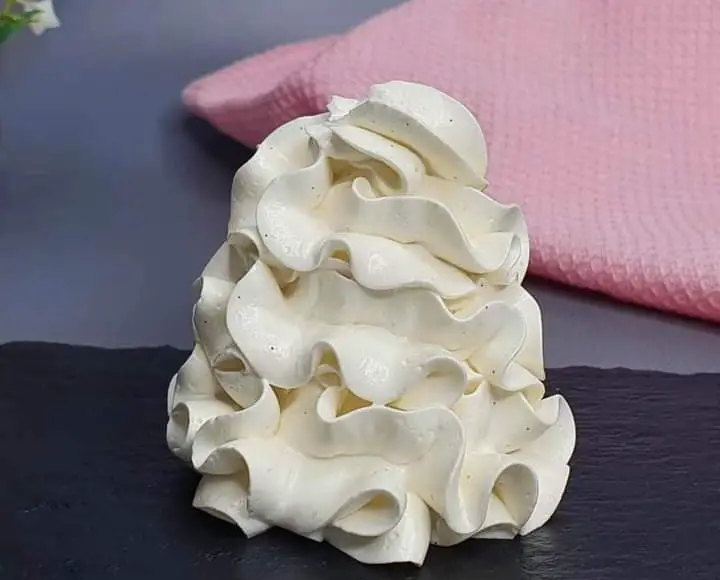Easy Buttercream Frosting Recipe
Introduction
Creating a delicious and easy buttercream frosting is an essential skill for any baker. Our Easy Buttercream Frosting recipe is designed to be simple yet indulgent, offering a smooth and creamy texture perfect for any cake or cupcake. This recipe makes three pounds of frosting, ideal for filling a Kitchen Aid mixing bowl. Whether you are a novice baker or a seasoned pro, this buttercream frosting will elevate your baked goods with its rich flavor and perfect consistency. Read on to discover the step-by-step guide, helpful tips, and answers to common questions about making the best buttercream frosting.
Equipment
- High-quality Mixer (recommended: Kitchen Aid Mixer)
Ingredients
- 1/2 cup pasteurized egg whites
- 1 lb powdered sugar
- 2 lbs salted butter, softened
- 2 tablespoons vanilla extract
Instructions
Step 1: Prepare the Base
- Combine Egg Whites and Sugar:
- In your mixer bowl, combine 1/2 cup pasteurized egg whites and 1 lb powdered sugar.
- Beat at medium speed for 5 minutes until the mixture is well combined and slightly frothy.
Step 2: Add Butter and Vanilla
- Add Butter and Vanilla:
- Gradually add 2 lbs of softened salted butter to the mixer, a few tablespoons at a time.
- Add 2 tablespoons of vanilla extract.
- Beat Until Fluffy:
- Continue to beat the mixture at medium speed for 10 minutes until the frosting becomes light and fluffy.
Tips for the Best Buttercream Frosting
- Flavor Enhancements:
- Use high-quality compounds and extracts like Amoretti to enhance the flavor of your buttercream. The finer the quality, the better the results.
- Egg Whites:
- Use pasteurized egg whites for safety and convenience. These can be found in the grocery store next to the eggs.
- Fresh egg whites can be used but will reduce the shelf life unless pasteurized. Avoid using meringue powder as it requires additional steps and precise measurements.
- Storage:
- Store the buttercream at room temperature (68-74°F) for up to two weeks.
- Refrigerate for up to two months.
- The day after making the buttercream, rewhip at medium speed for 5 minutes to restore its fluffy texture.
- Coloring:
- Use gel paste icing colors to tint your frosting. For deep colors, heat a small portion of the tinted buttercream in the microwave at low power (5 seconds at a time) to deepen the color without melting it. Add it back to the main batch and whip to combine.
- Smooth Finish:
- This buttercream does not crust and works best when chilled on the cake. For a smooth final coat, glide a spatula over the chilled frosting.
FAQs
Can I use fresh egg whites instead of pasteurized egg whites?
Yes, you can use fresh egg whites, but it will reduce the shelf life of the buttercream unless you pasteurize them yourself. Using pasteurized egg whites from the store is recommended for convenience and safety.
Why shouldn’t I use meringue powder?
Meringue powder requires dissolving in hot water and precise measurements, which adds extra steps and complexity to this easy recipe. Pasteurized egg whites provide a more straightforward and reliable result.
How long can I store the buttercream at room temperature?
You can store the buttercream at room temperature (68-74°F) for up to two weeks. Ensure the storage environment is within this temperature range to maintain the frosting’s quality.
How can I achieve a deep color for my buttercream?
To achieve a deep color, use gel paste icing colors. Heat a small portion of the tinted buttercream in the microwave at low power (5 seconds at a time) to intensify the color without melting. Mix this back into the main batch and whip thoroughly.
What should I do if my buttercream is too stiff?
If your buttercream is too stiff, you can add a small amount of milk or cream (a teaspoon at a time) and whip until you reach the desired consistency. Ensure not to add too much liquid at once to avoid making the frosting too runny.
How do I get a smooth finish on my cake?
For a smooth finish, chill the frosted cake and then use a spatula or a cake scraper to glide over the chilled frosting. This technique helps to create a smooth and even surface.
Conclusion
Mastering the art of making buttercream frosting opens up a world of possibilities for decorating cakes and cupcakes. This Easy Buttercream Frosting recipe is not only simple to follow but also yields a rich, creamy, and versatile frosting that will impress. Whether you’re preparing for a special occasion or just indulging in a sweet treat, this buttercream is sure to become a go-to recipe in your baking repertoire. Enjoy the delightful process and delicious results of creating your own homemade buttercream frosting!

